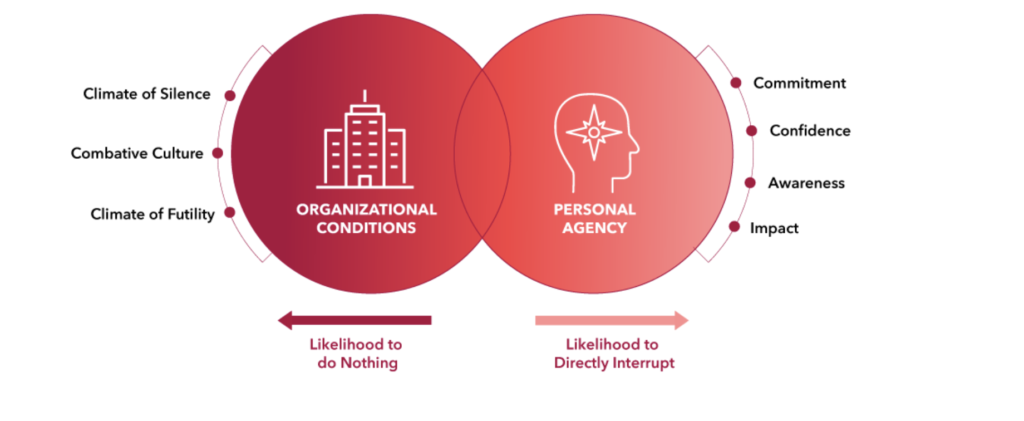
Sexism and gender bias affect health outcomes, particularly for women and girls, making it essential to identify and confront this pernicious system of oppression. At Vital Strategies, we are committed to addressing sexism in our public health work and ensuring we foster a workplace environment where everyone thrives. Recently, we were joined by Sarah DiMuccio, Senior Associate on the MARC (Men Advocating Real Change) research team and Negin Sattari, Director of the Research team at Catalyst—a global nonprofit that works around the world to accelerate women into leadership—who shared their research on how men can interrupt sexism in the workplace and beyond.
How do you define sexism? Can you elaborate on the covert vs. overt sexism spectrum and where, for example, microaggressions fit in?
Sexism can be defined as the discrimination, mistreatment, and/or objectification of people based on their sex, gender, or sexual orientation, which results from assumptions, misconceptions and stereotypes. Modern day sexism can take many forms. Sometimes it is intentional, visible, and unambiguous, or what we call overt sexism. A recent example is the outbreak of online criticism and harassment of 2021 Olympic gold medalist An San, the South Korean archer, because of her short haircut.
In many cases, however, sexism is subtle, hidden and invisible, or as is called, covert. For example, when women are assumed to be better at taking care of administrative tasks and event planning in the workplace. Subtle sexism can also include actions or comments that seem well-intended and sometimes even seem complimentary, but which in reality still perpetuate stereotypes and harmful assumptions about certain groups. For example, when women are not offered the chance to take on high risk or physically demanding tasks, ostensibly to be protected. While different in content, both overt and covert forms of sexism serve to reinforce problematic gender stereotypes which further perpetuate gender inequality.
Microaggressions, which we define as “subtle and/or n on-subtle actions, statements or phrases that invoke derogatory stereotypes towards an individual or group of people based on their status in a marginalized group,” definitely covers a wide range of behaviors that also would be considered covertly sexist.
What are some of the implications of your research for women’s health?
Given that work occupies a large portion of people’s daily lives, workplaces are major contexts for exposure to sexism and other harmful behaviors and practices. Some research evidence shows that sexism against women in the workplace is associated with poorer mental and physical health. We believe that these harmful effects cannot be eradicated without an active partnership from men who have an outsized presence in higher level ranks in workplaces.
Our findings in our “Interrupting Sexism” research series show that to tap into men’s engagement as a unique resource for removing sexism, organizations must make larger transformations in organizational culture and create conditions in which men are enabled to interrupt incidences of sexism in the moment they happen. It takes highly committed and well-aware men in the right type of organizational environment to help prevent sexism and its harmful effects on women’s health in the workplace.
You have researched what compels men to respond to sexism in the workplace, can you tell us about the research and findings? Do you think that these same findings can be applied to other areas outside of the workplace?
In our research, we explore the conditions that either encourage or discourage men from speaking up when they witness sexism. We have found that men who are highly committed to dismantling sexism, confident in their ability to interrupt sexism, aware of the positive benefits of doing so, and invested in its impact on the common good are more likely to directly interrupt sexism, which is not surprising. However, across three published reports, we have also found that those individual level characteristics are not enough.
Negative organizational climates are highly influential in discouraging men from interrupting sexism. Specifically, men are much more likely to say that they wouldn’t do anything in respond to sexism if they perceive their organization to be silencing, futile and/or combative. In addition, our recent research showed that societal norms toward masculinity and manhood are important pieces of the puzzle that cannot be ignored. We have found that men’s experience of stress around living up to masculine ideals (what we call “masculine anxiety”) is related to a reluctance to interrupt sexism–a relationship that is made stronger in highly combative cultures.
While our research is focused on workplace context, we believe that these findings have implications beyond the workplace. Some societal and cultural norms in addition to actions of those in positions of power can promote negative environments in which individuals are disempowered and unable to speak up against problematic issues in any context. For example, community groups or even families can be exposed to climates of silence, futility, or combative cultures. These patterns can emerge in any context where hierarchies of power exist.

How do cultural constructs and societal context factor into men’s ability to respond to sexism toward women at work?
Broader societal and cultural norms are very important when thinking about men’s understandings of and reactions to workplace sexism. Gender (in)equality and attitudes toward women vary a great deal in scope and form across cultures. Our research, however, is built on the assumption that organizations across countries and cultural contexts are in unique positions to build local cultures in which sexism is not tolerated, and to mobilize men to be active agents of change in the workplace and beyond. As we mentioned before, the workplace is where many people (and especially men in countries with male dominant labor markets) spend the largest portion of their time. Therefore, regardless of their main mission and function, organizations can transform the mindset, beliefs and behaviors of their employees in positive ways. It is due to this assumption that we decided to collect our data from multiple countries in North America, Europe, and Asia Pacific. Our data supports the assumption that regardless of the context, organizations can be strongly influential in men’s responses to workplace sexism.
How can we create work environments in which men can be agents of change when they witness sexism?
In our reports, we provide numerous action recommendations for organizations to consider. Here are a few examples of actions that leaders, in particular, can take to quash silencing, futile and combative cultures.
- First, leaders can evaluate their organizational cultures closely and identify any structures in place that normalize silence, sense of futility, or ruthless competition. They can draw on multiple sources of input such as anonymous surveys, focus group discussions, company policies and one-on-one conversations.
- We also encourage leaders to engage in inclusive leadership behaviors, an important segment of which is looking inward by promoting humility and admitting that they don’t have all the answers–making it okay to admit failure.
- Leaders should also serve as role models who set the tone by promoting values like safety, respect, growth, and work-life balance. Such adjustments by leaders, among others, can make positive changes in organizational cultures which then have many positive outcomes. One such positive outcome, based on our research, is improving the conditions for men to become active agents of addressing sexism when it happens.
Visit Catalyst.org to learn more, and read Negin and Sarah’s most recent work.
Get Our Latest Public Health News
Join our email list and be the first to know about our public health news, publications and interviews with experts.
About Vital Strategies
Vital Strategies is a global health organization that believes every person should be protected by a strong public health system. We work with governments and civil society in 73 countries to design and implement evidence-based strategies that tackle their most pressing public health problems. Our goal is to see governments adopt promising interventions at scale as rapidly as possible.
Follow us on Twitter @VitalStrat.